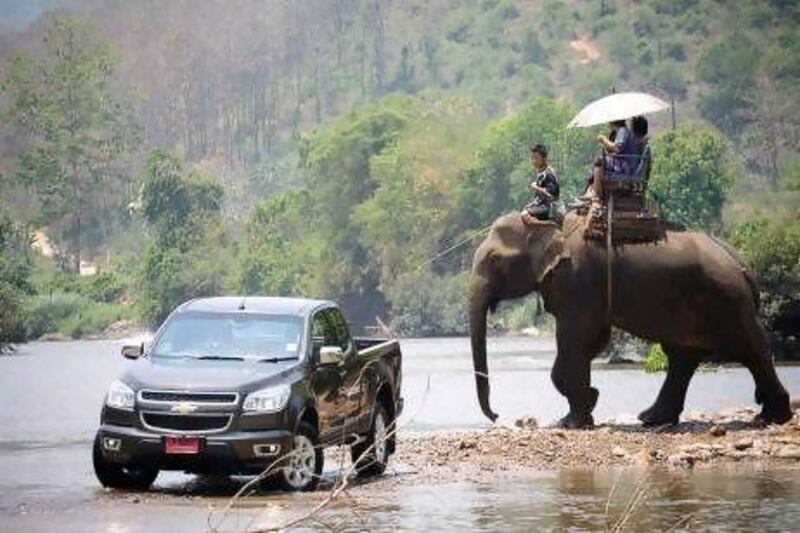Quick, what is the second largest market in the world for pickup trucks? No, not the first - anyone who's watched The Fall Guy will know that it's obviously the United States, land of the eternal F-150 and Silverado. Number two is not what you would expect; not China, not India, but Thailand - the land of a thousand smiles that buys more pickup trucks per capita than anyone else in the world.
Yes, strange as it may seem, the land of Buddhism is also the Asian home of the pickup truck. Thanks to abundant government incentives, small pickups comprise more than 40 per cent of the vehicle market. While neighbours such as Malaysia and Vietnam prefer the anonymity of small Japanese saloons or family busting, mid-size vans, the streets of Bangkok are rammed with one-tonne mid-size pickups of every possible variation and style, jostling for space with tuk-tuk taxis and badly ridden motorbikes.
Don't expect the white nondescript commercial vehicles you find in the Middle East. In Thailand, your pickup is your canvas for personal expression, your family estate car, a weekend adventure toy and, for many young men, the best means available of getting a date. Competition to stand out is fierce and owners vie furiously to design a more outrageous truck with wilder colours, bigger bull bars or ever more stickers on the side. Remember Marty McFly's wicked black Toyota Hilux from Back to The Future? In Thailand, that would be considered tame.
Speaking of the Hilux, Toyota's popular utility has long ruled the global market, with a reputation for rugged reliability, but in the last year several rivals have emerged for the crown, from Volkswagen's plush Amarok to Ford's supersize Ranger. The latest is Chevrolet's Colorado, which, like its Isuzu D-Max twin-under-the-skin, is built in Thailand and exported to more than 18 countries across the world, from Russia to the United States.
Making Thailand the base for Colorado was an obvious choice, says Martin Apfel, president of General Motors Thailand and South East Asia. "Ninety two of our 173 truck dealers are in Thailand," he says. "This is the largest mid-size truck market in world. Every second vehicle sold here is a mid-size truck. We wanted to build where we sell."
Indeed, the region's appetite for these trucks appears almost insatiable. Apfel expects GM to add close to 100 dealers in Thailand, Indonesia, Malaysia and Pakistan over the coming year - all being fed from the main manufacturing plant in Rayong Province. Despite the disturbance caused by last year's flooding, the plant can now supply 180,000 units a year while the sister powertrain assembly line can pump out 130,000 engines a year. And even that still may not be enough, with a second line being put in at a cost of US$500 million (Dh1.8 billion).
"This area is just pure growth," Apfel admits. "We're currently in the 4,600-employee range but, in six months, we expect 5,200 employees in Thailand alone. Keep in mind, Thailand has less than one per cent unemployment - this is a red-hot labour market."
Customers like these want more from their trucks than just a tool, so manufacturers are reaching far into their pockets to satisfy those needs. Colorado is no exception, costing nearly $2bn over its five-year development cycle and racking up 2.5 million test kilometres - the equivalent of six trips to the Moon. You would drive that much, too, if you have to create a lineup with 26 variants including - deep breath - low and high stance versions, single and extended and crew cabs, wide and narrow bodies and, of course, two-wheel or four-wheel-drive cars. That's what Thailand will get; here in the GCC we will get a mere 12.
GM Brazil took the design lead on the Colorado and came up with a handsome, broad-shouldered body that employs all the requisite macho cues, which is also shared with the upcoming Trailblazer 4x4. Still, even in this most utilitarian of markets, concessions have to be made, as Dagoberto Tribia, GM Brazil's director of interior design, explains.
"We did customer clinics in Thailand and Australia and the feedback was always that it should not be too truck-like, but more car-like, while still powerful and robust."
Believe it or not, those car-like cues stem from the Camaro. Not seeing it? Look closely at the stacked rear tail lights that subtly mimic the boxy cut-outs for the Camaro tail. Probably too subtle for most but you definitely won't miss the Camaro influence in Tribia's interior - the instrument cluster is a direct copy of the one found in the famous muscle car, with another unconventional touch being the rotary telephone dial controls used for the HVAC system. Fit and finish is generally good but don't expect soft-touch materials anywhere and, as for colour choices? You'd better like grey, grey and lots more grey.
Fortunately, Thailand is here to provide the rest of the flair. For the launch of the Colorado, GM whisked us away up north to the stunning, winding mountain roads of Chiang Rai, where pickups are virtually the only form of transport for your goods, livestock, family and, sometimes, all of the above simultaneously. Despite being more than 800km away from Bangkok, Chiang Rai still bears all the classic tourist trap trademarks: a walking street with a night market that sells cut-price knick-knacks and abundant fake goods, touts everywhere trying to haul you into seedy bars under fading sodium lamps and enough cheap, delicious street food to make you wonder why you ever paid more than Dh5 for a meal.
The roads here are generally well surfaced but quite treacherous with steep drop-offs higher in the hills, sharp bends and few signposts to make you aware of the fact. Good thing, then, that the Colorado feels quite agile and car-like in its handling, without too much in the way of body roll. The steering has a decent heft and makes the big Colorado easy to place in the bends with the added bonus of a surprisingly short turning circle. If there is a criticism, it's the brakes that could do with more bite but, then again, one must remember this is a commercial vehicle with drums at the back. As long as you judge it by those standards, the Colorado feels perfectly adequate, if no revelation.
Off-roading is where the truck truly feels in its element. The Thai version is considerably different - and slower - than what we're used to in the UAE, with steep, slippery hills and exceedingly narrow mountain paths being your main obstacles, not to mention suicidal oncoming traffic. In these conditions, a regular SUV would simply be too big, but the nimble Colorado threads its way through the hills effortlessly, with the low-range box never needing to be called into action.
At launch the Colorado will be available with four engine choices. The first is the one that will make up the bulk of sales in the GCC: a 2.4L, 150hp petrol four-cylinder unit. For a workhorse motor, it's surprisingly refined and feels more than sufficient torque-wise for most applications. Or rather, it does until you drive the foreman's special 3.6L V6, which redefines effortless progress and comes only with a slick-shifting six-speed automatic for that mini-SUV feel.
But the best engine of the lineup - and one that we won't get until next year thanks to the high global demand - is the new Duramax turbodiesel, available in either 2.5L, 150hp or 2.8L, 180hp variants. I spent most of the trip driving the latter and can report that it's one fine motor, especially hooked up to the automatic instead of the slightly vague and notchy five-speed manual. There's a little turbo lag below 2,500rpm but a mountain of torque - 469Nm, to be precise - available afterwards to make overtaking a simple matter of flexing your right foot. That much grunt is easily enough to chirp the tyres in third, and in the sand would be the off-roader's choice.
While it may be a stonking success in South East Asia, the current Colorado is a negligible player in the Middle East, accounting for just over one per cent of a market that sells 120,000 vehicles annually. Chevrolet has modest hopes for this new pickup, aiming to move up to a 10 per cent share over the next year in a segment dominated by Toyota and Nissan. The new Colorado doesn't really redefine the segment but it's a solid, modern contender - and sometimes, that's all you need.






